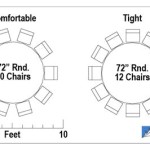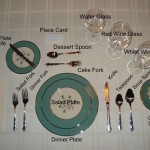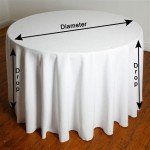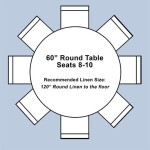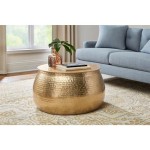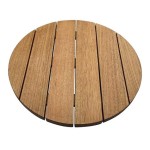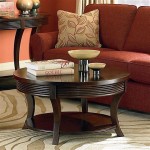What Can You Use Instead of a Tablecloth?
Tablecloths have traditionally served as both functional and decorative elements for dining tables. They protect the table surface from scratches, spills, and heat damage, while also contributing to the aesthetic appeal of the room. However, tablecloths are not always the most practical or desirable option. They can be cumbersome to clean, require ironing, and may not suit all interior design styles. Fortunately, numerous alternatives exist that offer similar benefits and can even enhance the dining experience in different ways.
Choosing an alternative to a tablecloth often depends on the table's material, the desired level of formality, the frequency of use, and personal preferences. Some alternatives prioritize protection, while others focus on aesthetics or ease of maintenance. The following provides an exploration of several viable substitutes, considering their respective advantages and drawbacks.
Placemats: Individual Protection and Style
Placemats are a versatile and widely used alternative to tablecloths. These individual mats are placed under each diner's setting, protecting a specific portion of the table from spills and scratches. Placemats come in a vast array of materials, shapes, sizes, and designs, offering considerable flexibility in matching different table styles and décor themes.
Materials used for placemats range from traditional fabrics like cotton and linen to more durable and easy-to-clean options like vinyl, cork, bamboo, and silicone. Fabric placemats offer a classic and elegant look but require washing and ironing similar to tablecloths. Vinyl and silicone placemats are stain-resistant and can be easily wiped clean, making them ideal for everyday use and families with young children. Cork and bamboo placemats offer a natural and rustic aesthetic and are generally heat-resistant.
The size and shape of placemats can also influence their suitability. Rectangular placemats are a common choice, fitting well on most rectangular or oval tables. Round placemats can soften the look of a square or rectangular table and are particularly suitable for round tables. The size should be adequate to accommodate a dinner plate, cutlery, and a glass without feeling overly crowded.
Furthermore, placemats allow the natural beauty of the table to be showcased. If the table has an attractive wood grain or a unique design, using placemats instead of a tablecloth highlights its features. They are also easily stored when not in use, requiring less space than a tablecloth.
Table Runners: A Touch of Elegance and Visual Interest
Table runners are long, narrow strips of fabric that run lengthwise down the center of a table. They offer a decorative element without completely covering the table surface, providing a balance between protection and aesthetic appeal. Table runners can be used alone or in conjunction with placemats to create a more layered and sophisticated look.
Similar to tablecloths and placemats, table runners are available in a wide variety of materials, colors, patterns, and textures. Fabric runners, such as silk, linen, or velvet, can add a touch of elegance and formality, while more casual options like cotton or burlap can create a relaxed and rustic atmosphere. The choice of material should complement the overall décor of the room and the style of the table.
Table runners can be used to define a specific area on the table, such as highlighting a centerpiece or creating a focal point for a buffet. They can also be used to visually connect different elements of the table setting, such as matching the color of the runner to the color of the napkins or serving dishes.
When choosing a table runner, it is important to consider the size and shape of the table. The runner should be long enough to drape slightly over the ends of the table, creating a balanced and aesthetically pleasing look. The width of the runner should also be proportional to the width of the table, generally covering about one-third to one-half of the table's surface.
Maintenance requirements for table runners vary depending on the material. Fabric runners typically require washing and ironing, while other materials, such as synthetic fabrics or beaded runners, may require spot cleaning or dry cleaning.
Bare Table: Showcasing the Natural Beauty of the Table
Leaving the table bare is a simple yet effective alternative to using a tablecloth. This option works particularly well for tables made of attractive materials, such as solid wood, marble, or glass. It allows the natural beauty of the table to be the focal point of the dining area.
Choosing to leave a table bare necessitates ensuring the table surface is in excellent condition. This may involve regular cleaning and polishing to maintain its shine and protect it from scratches and stains. Using coasters and placemats can help to minimize the risk of damage from hot dishes and spills.
The bare table approach is often favored in minimalist or modern interior design styles, where simplicity and functionality are valued. It can create a clean and uncluttered look, allowing other elements of the room, such as the chairs, lighting, or artwork, to take center stage.
While leaving the table bare can be visually appealing, it may not be the most practical option for tables that are frequently used or prone to damage. In such cases, a protective coating or sealant can be applied to the table surface to enhance its durability and resistance to scratches and stains. Regular use of furniture polish can also help to maintain the table's luster and prevent it from drying out.
The formality of the occasion should also be considered when opting for a bare table. While it can be appropriate for casual gatherings and everyday meals, a tablecloth or runner might be preferred for more formal events.
Hard Tabletop Protectors: Prioritizing Functionality and Protection
For those primarily concerned with protecting their table from damage without sacrificing the look of the natural table, hard tabletop protectors are a viable option. These protectors are typically made from materials like tempered glass, acrylic, or vinyl and can be custom-cut to fit the exact dimensions of any table.
The primary advantage of hard tabletop protectors is their durability and resistance to scratches, stains, and heat. They provide a protective barrier between the table surface and potential sources of damage, extending the lifespan of the table. Tempered glass protectors offer a particularly high level of protection and are virtually invisible, allowing the beauty of the table to shine through.
Acrylic protectors are a lighter and more affordable alternative to tempered glass. They are also highly transparent and can be easily cleaned with soap and water. Vinyl protectors are the most budget-friendly option but may be less resistant to heat and scratches than glass or acrylic.
When choosing a hard tabletop protector, it is important to consider the thickness of the material. Thicker protectors offer greater protection but may also be more expensive. The edges of the protector should also be smooth and rounded to prevent injuries.
While hard tabletop protectors offer excellent protection, they may not be the most aesthetically pleasing option for all dining tables. Some people may find them to be too sterile or impersonal. However, they can be a practical choice for protecting valuable or antique tables.
Fabric Pieces: Versatile and Creative Alternatives
Beyond traditional tablecloths and runners, various other fabric pieces can be used to decorate and protect a table. These options offer a creative and personalized approach to table dressing, allowing for greater flexibility in design and style.
Quilts and throws can be used as tablecloths, adding a touch of warmth and texture to the dining area. They are particularly suitable for casual gatherings and can create a cozy and inviting atmosphere. Vintage scarves can also be used as table runners or individual placemats, adding a unique and eclectic touch.
Lace doilies can be used to protect small areas of the table, such as under vases or serving dishes. They add a delicate and intricate detail to the table setting and can be particularly suitable for vintage or romantic décor styles.
Individual napkins can also be used as placemats, providing a simple and elegant way to protect the table surface. Linen napkins are a classic choice, while more casual options like cotton or paper napkins can be used for everyday meals.
The key to using fabric pieces creatively is to experiment with different colors, patterns, and textures to find the look that best suits the individual style and the occasion. Layering different fabric pieces can also create a more complex and visually interesting table setting.
Consider the practicality of each fabric choice. Heavily embellished fabrics may be beautiful but difficult to clean. Lighter fabrics may stain easily. Choosing fabrics that are both aesthetically pleasing and easy to maintain is the ideal balance.
In conclusion, numerous appealing and practical alternatives to tablecloths exist. Choosing the most appropriate option involves considering factors like table material, desired formality, ease of maintenance, and personal aesthetic preferences. A thoughtful selection can protect the table while enhancing the dining environment.

10 Party Tablecloth Alternatives The Daily Hostess

How To Set A Beautiful Table For Any Season Affordable Tablecloth Sources Sanctuary Home Decor

20 Alternative Table Runners

Don T Have The Perfect Tablecloth Use A Cozy Colorful Throw Instead Between Naps On Porch

Smocked Table Runner Country Design Style

How To Set A Beautiful Table For Any Season Affordable Tablecloth Sources Sanctuary Home Decor

Smocked Table Runner Country Design Style

Creations Table Runner Tricks And Tips The Painted Apron

How To Make A Short Table Runner I Should Be Mopping The Floor

Diy Instead Of A Tablecloth I Wrapped My Tables With Wrapping Paper Makes The Clean Up Much Easier
Related Posts

